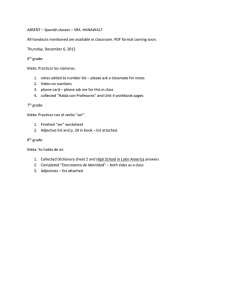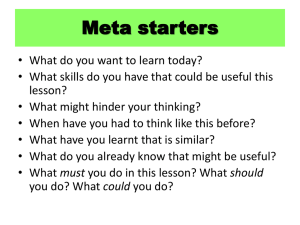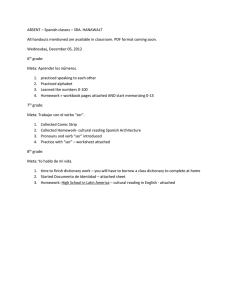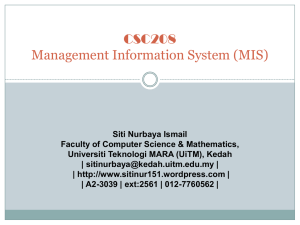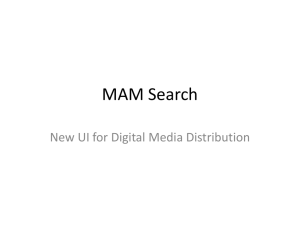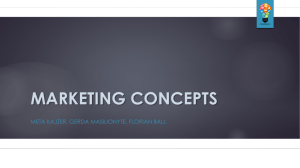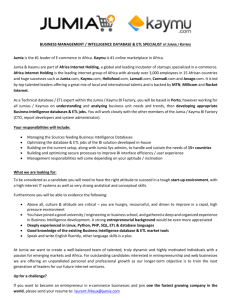Business Intelligence Project
advertisement
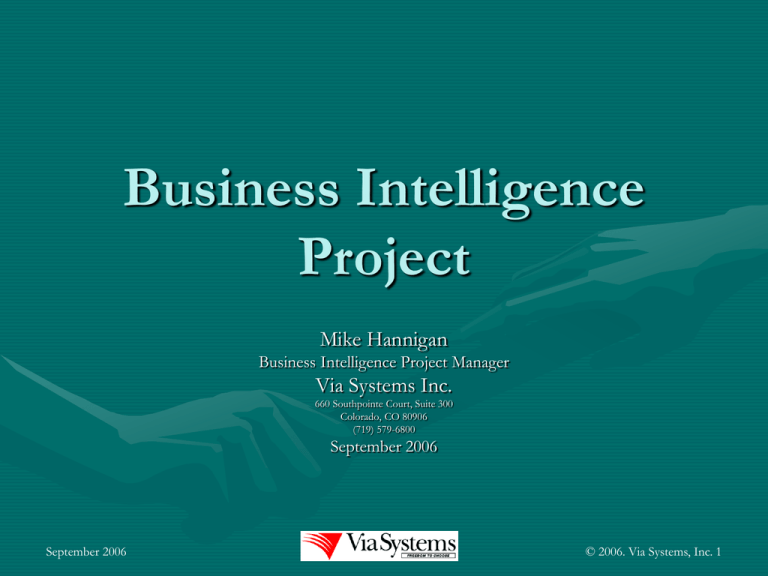
Business Intelligence Project Mike Hannigan Business Intelligence Project Manager Via Systems Inc. 660 Southpointe Court, Suite 300 Colorado, CO 80906 (719) 579-6800 September 2006 September 2006 © 2006. Via Systems, Inc. 1 Business Intelligence Definition: “Analysis of business data. Business Intelligence is the name given to a class of software tools specifically designed to aid analysis of business data. BI tools have traditionally been associated with indepth analysis of historical transaction data, supplied by either a data warehouse or an online analytical processing (OLAP) server linked to a database system. BI has a wide range of commercial and non-commercial applications, with the most common being the analysis of patterns such as sales and stock trends, pricing and customer behavior to inform business decision-making. For this reason it is sometimes referred to as decision support software.” Source: Procullux Media Ltd., 2005 September 2006 © 2006. Via Systems, Inc 2 Introducing Business Intelligence BI focuses on the “outside,” and should be seen as a company’s radar unit, scanning the external environment for opportunities and dangers. September 2006 © 2006. Via Systems, Inc 3 It’s not just another term for Market Research…. Good BI is broader in scope and more forwardlooking than market research. September 2006 © 2006. Via Systems, Inc 4 Fundamentals “Business Intelligence initiatives are expensive endeavors. Disparate business data must be extracted and merged from online transaction processing (OLTP) systems, from batch systems and from external data sources. Business Intelligence decisions – support initiatives also call for new technology, additional tasks to be performed, roles and responsibilities to be shifted, and analysis and decision-support applications to be delivered quickly while maintaining acceptable quality.” Source: BI Review, 2005 September 2006 © 2006. Via Systems, Inc 5 Fundamentals “Sixty percent of Business Intelligence projects end in abandonment or failure because of inadequate planning, missed tasks, missed deadlines, poor project management, undelivered business requirements, or poor quality of the deliverables.” “Failure to Plan is a Plan for Failure” Source: DMReview by Jonathan Wu, October 2000 September 2006 © 2006. Via Systems, Inc 6 Fundamentals • Unlike static stand-alone applications, a properly designed BI system cannot be built in “one big bang” • Data and functional capabilities must be rolled out in iterative releases • BI applications are very different from standalone applications September 2006 © 2006. Via Systems, Inc 7 Fundamentals Do we know the type of customers we have? Can we forecast longterm buying habits of our customers? Do we know why we are losing market share? September 2006 Are our products & services priced competitively? Do we know what our best customers have in common? © 2006. Via Systems, Inc 8 Fundamentals • Business Intelligence vs. Standard Application • Business opportunity • Implement across the organization • Strategic Information requirements • Best deployed as release/evaluate environment September 2006 • Business needs • Department decision support • Operational functional requirements • Best released at the same time with all functional capabilities © 2006. Via Systems, Inc 9 Fundamentals • BI requires a Cross-organizational development approach – – – – – – – – Information consolidation Seamless business functionality Information integration Streamlined organizational business processes Information integrity Organization changes Corporate culture shifts Parallel development tracks (subprojects) September 2006 © 2006. Via Systems, Inc 10 Fundamentals Business Intelligence Project Lifecycle: Justification Deployment Planning September 2006 Business Analysis Design Construction © 2006. Via Systems, Inc 11 Outline (Sixteen Steps) Justification Design 1. 8. Database Design 9. ETL Design 10. Meta Data Repository Design Business case assessment Planning 2. 3. Enterprise Infrastructure Evaluation Project Planning Business Analysis 4. 5. 6. 7. Project Requirements Document Data Analysis Application Prototyping Meta Data Repository Analysis Note: ETL - Extract/Transform/Load September 2006 Construction 11. 12. 13. 14. ETL Development Application Development Data Analysis Meta Data Repository Development Deployment 15. Implementation 16. Release Evaluation © 2006. Via Systems, Inc 12 Presentation Notes • Handouts • Two slides with – Activities (do) – end of each step – Deliverables (produce) – end of each section/stage September 2006 © 2006. Via Systems, Inc 13 Stage One Justification September 2006 © 2006. Via Systems, Inc. 14 Stage One: Justification (1) Business case assessment • The business problem or business opportunity is defined • Cost-justified • Define the benefit • Solving a business problem or taking advantage of a business opportunity • Balance between the costs involved and the benefits gained • Must be business driven not technology driven September 2006 © 2006. Via Systems, Inc 15 Business Justification Components September 2006 Business Drivers Cost Benefit Business Analysis Risk Assessment © 2006. Via Systems, Inc 16 Business Drivers • Strategic business goals of the organization • Substantiate business justification i.e. – Customer satisfaction – Reduced costs – Critical business data available • Must be in line with the company’s business direction September 2006 © 2006. Via Systems, Inc 17 Business Analysis • What business issues will be resolved? • Define information requirements for the business issue • Determine subject area, level of detail, internal data and external data needed • Identify the user community • Possible data sources – Online Transaction Processing (OLTP) – Private data (internal department data) – External data (i.e. statistics, customer profiles, credit reports, etc. September 2006 © 2006. Via Systems, Inc 18 Cost Benefit • Warning: ROI can be difficult to cost justify • Remember do not justify by solving operational problems • How are you solving a business problem? • What new business opportunities will be available? September 2006 © 2006. Via Systems, Inc 19 Risk Assessment • • • • All projects have risk Identifying risk triggers Create a mitigation plan for all important risks Create a contingence plan for all important risks September 2006 © 2006. Via Systems, Inc 20 Risk Assessment Variable Low Medium Technology Experienced with technology Minimal experience with technology New technology little experience Complexity Simple, minimal workflow impact Moderate, some workflow impact Mission critical, requires extensive work Integration Stand-alone Limited integration Extensive integration Organization Solid internal support Supportive to a large extent Little internal support Project Team Business experience, talented, great attitude Some business experience, talented, fair attitude No business experience, only technology-driven, bad attitude Financial Investment ROI in short time ROI within a moderate time frame ROI after a few years September 2006 High © 2006. Via Systems, Inc 21 Business Case Justification Activities 1. Determine business need 2. Assess current solution 3. Access operational sources and procedures 4. Access competitors BI support initiatives 5. Determine BI application objectives 6. Propose BI solution 7. Perform cost benefit analysis 8. Perform risk assessment 9. Write assessment report September 2006 © 2006. Via Systems, Inc 22 Justification Deliverable Business case assessment report • Strategic business goals • Objectives of the proposed BI application • Statement of the business need • Explain how the BI application will satisfy the business need • Ramifications of not addressing the business need • Cost-benefit analysis • Risk assessment • Recommendations Note: Remember to include an executive overview September 2006 © 2006. Via Systems, Inc 23 Stage Two Planning September 2006 © 2006. Via Systems, Inc. 24 Stage Two: Planning (2) Enterprise infrastructure to support the crossorganization initiatives – Technical infrastructure – Non-Technical infrastructure (3) Project Planning – Including scope, time, budget, staff, technology, business representatives and sponsors – Include in the plan must be detailed plans to track and report progress September 2006 © 2006. Via Systems, Inc 25 Planning the Technical Infrastructure • • • • Description of the current structure Plan the future structure (changes) Middleware to the DBMS DBMS requirements September 2006 © 2006. Via Systems, Inc 26 Middleware Platform • Middleware – Runtime software • Client/Server Architecture • Middleware categories – Distributed Logic Middleware: supports program-toprogram communications between two pieces of custom application code – Data Management Middleware: connects an application or DBMS on one platform with a DBMS running on another platform September 2006 © 2006. Via Systems, Inc 27 DBMS Platform • • • • • • • • • • • • • Handling queries and data load Database scalability Internet integration Availability of advanced index schemes Unattended operations Network support Administrative support Future use/expansion Hardware scalability Query performance Load process and performance Security system Data dictionaries September 2006 © 2006. Via Systems, Inc 28 Technical Infrastructure • • • • • • Data volumes Update frequency Data access patterns Number of reports and queries Number of people accessing the BI database Number of tools running against the BI database • Number of data feeds for the BI database September 2006 © 2006. Via Systems, Inc 29 Technical Infrastructure Evaluation Activities 1. Assess existing platform 2. Evaluate and select new products 3. Expand current platform 4. Write technical Infrastructure report September 2006 © 2006. Via Systems, Inc 30 Planning the Non-Technical Infrastructure • Assess effectiveness of non-technical infrastructure components • Write non-technical infrastructure assessment report • Improve non-technical infrastructure September 2006 © 2006. Via Systems, Inc 31 Enterprise Standards • • • • • • • • • • Development Approach Data naming and abbreviations Meta data capture Logical data modeling Data quality Testing Reconciliation Security Service-Level Agreement (SLA) Policies & Procedures September 2006 © 2006. Via Systems, Inc 32 Technical Infrastructure Evaluation Activities 1. Assess effectiveness of non-technical infrastructure 2. Improve non-technical infrastructure 3. Write non-technical Infrastructure report September 2006 © 2006. Via Systems, Inc 33 Project Planning • Managing the BI project • Plan for setbacks • Creating a project charter – – – – – – – Goals & objectives Scope issues Project risks Constraints Assumptions Change Control Issues Management • Project planning activities September 2006 © 2006. Via Systems, Inc 34 Project Planning – Simple Terms • • • • What will be delivered? When will it be done? How much will it cost? Who will do it? September 2006 © 2006. Via Systems, Inc 35 Four Major Project Constraints Effort Budget September 2006 Scope Resources © 2006. Via Systems, Inc 36 Scope • • • Impossible to create a valid estimate for a project without a solid understanding of the scope Traditionally, scope is measured in functions performed BI projects should be measured by data elements – Analysis and preparation of data takes much longer – Assume 80% effort for data and 20% effort for function Note: It is not reasonable to request a significant scope change to a carefully deliberated and agreed-upon project plan without adjusting any of the other constraints. September 2006 © 2006. Via Systems, Inc 37 Project Risks • Every project has risks • Risks are unavoidable • Use the Risk Assessment generated in Stage 1 (Business case analysis) • Depending on the likelihood and the impact on the project a mitigation and/or contingency plan should be in the project plan – Triggers are situations that signal a potential, perhaps imminent materialization of a risk – The mitigation plan specifies what action the project team can take to prevent the risk from materializing – The contingency plan specifies alternatives in case the risk does materialize September 2006 © 2006. Via Systems, Inc 38 Project Risks • Common project risks – – – – – – – – – – Lack of management commitment Lack of business participation Imposed, unrealistic schedule Unrealistic scope for the schedule Unrealistic budget Unrealistic expectations Untrained or unavailable staff Constantly changing business priorities Ineffective project management Limited scalability September 2006 © 2006. Via Systems, Inc 39 Constraints • • • All projects are subject to the same project constraints: Effort, Scope, Budget & Resources In reality, there is a fifth constraint: Quality Quality and Effort (time) are polarized constraints –Higher quality requires more effort –Since time is a driving factor for most originations, Effort always has top priority Note: For a BI project, quality should have a higher priority than any other constraint: Quality, Effort, Scope, Budget & Resources September 2006 © 2006. Via Systems, Inc 40 Assumptions • Anything taken for granted • (Wrong assumptions become risks) • Important assumptions should have a counterpart risk, identifying triggers, a mitigation plan and contingence plan September 2006 © 2006. Via Systems, Inc 41 Change Control • Manage change • Curb scope creep • Change (unless minute) always impacts the project – Effort (time), Scope and Quality – Sometimes Budget and Resources • Changes should be submitted to change control board • Changes must be logged and reviewed/approved by Change Control Board and tracked in project meetings • Change log of the following information should be kept and updated: Change number, Change date, Change description, Status (approved, not approved or deferred), Current status or Resolution and Closed date September 2006 © 2006. Via Systems, Inc 42 Change Control Board • Each change that must be added to a project requires a business decision: – Cut back on the current scope – Extend the deadline – Declare the change “not applicable” to the current release and postpone it – Incorporate the requested change in the next release – Eliminate complicated transformations, edit checks, and testing (impacts Quality) September 2006 © 2006. Via Systems, Inc 43 Issues Management • Issues, related to business or technical concerns, always occur during a project • Issues need to be tracked and managed • Every issue needs to be assigned to a person who has the responsibility to get resolution • Issues must be logged and reviewed and tracked in project meetings • Issue log of the following information should be kept and updated: Issue number, Issue date, Issue description, Assigned to, Action taken, Action Date, Resolution and Closed date September 2006 © 2006. Via Systems, Inc 44 Planning the BI Project • • • • Not a one-time activity Estimates must be adjusted frequently The more detail you have in the first version of the project plan, the easer it will be to manage the project Sequence of activities for preparing a project plan (software available for these activities) – – – – – – – • • Create a work breakdown structure (WBS) listing activities, tasks and subtasks Estimate the effort hours for each activities, tasks and subtasks Assign resources for each activities, tasks and subtasks Determine the task dependencies Determine the resource dependencies Determine the critical path based on the dependencies Create the detailed project plan Expect to revisit and rework the plan often based on development activities Needs to be revisited when a Change is approved for this project by the Change Review Board September 2006 © 2006. Via Systems, Inc 45 Estimating Techniques • Historical, based on learned patterns (how long it took on the last project) • Intuitive, based on intuition and experience (“gut” estimating) • Formulaic, based on the average of possibilities Best Estimate + (Average Estimate X 4) + Worst Estimate 6 September 2006 © 2006. Via Systems, Inc 46 Resource Assignment • Effort estimates cannot be completed until the activities and tasks are assigned • Estimates must take into consideration each team member’s skill level • Remember to take into account – Administrative factors: meetings, other projects, emails, in-baskets, training, etc. – Non-work-related: vacation, illness, jury duty, personal time off, medical appointments, holidays September 2006 © 2006. Via Systems, Inc 47 Task Dependencies • Not all activities and tasks have to be performed serially • Many can be performed in parallel • Identify task dependencies: – – – – – – – – Finish to Start Finish to Start T2 cannot start until T1 finishes Task 1 Start to Start Task 2 T2 can start with T1 Finish to Finish Finish to Finish T2 cannot finish until T1 finishes Start to Finish Task 1 T2 cannot finish until T1 starts Task 2 September 2006 Start to Start Task 1 Task 2 Start to Finish Task 1 Task 2 © 2006. Via Systems, Inc 48 Project Schedules • Once you have all the tasks, resources, dependencies and estimates you can create a project schedule • Creating a useful plan requires effort • Once done adjusting it is not labor intensive • Using a proper software tool, any changes automatically cascade through the entire project • Get a skilled Project Manager September 2006 © 2006. Via Systems, Inc 49 Planning Activities 1. Determine project requirements 2. Determine condition of source files and database 3. Determine or revise cost estimates 5. Identify Critical Success factors 4. Revise risk assessment 6. Prepare project charter 8. Kick off project 7. Create high-level project plan September 2006 © 2006. Via Systems, Inc 50 Planning Deliverables • Technical infrastructure report – Scalability & Limitations: Servers, Workstations, OS, Middleware, Network, DBMS, Software, etc. • Non Technical infrastructure report – Standards, Methodology, Estimating guidelines, Scope management, Issues management, Roles/Responsibilities, Security process, Meta data capture, Process for merging logical data, Data quality, Testing process, SLA’s, Support, Dispute resolution, Communication process, etc. September 2006 © 2006. Via Systems, Inc 51 Planning Deliverable (continue) Project Charter • Represents the agreement between the IT staff and business sponsor – – – – – – – – – Goals and objectives Statement of business problem Proposed BI solution Results from cost-benefit analysis Results from the infrastructure gap analysis Functional project deliverables Subject areas to be delivered High-level logical data model Items not within the project scope September 2006 © 2006. Via Systems, Inc 52 Planning Deliverable (continue) Project Charter (continue) – – – – – – – – – – Condition of the source files and database Availability of security requirements Access tool requirements Roles and responsibilities Team structure (core and external) Communication plan Assumptions Constraints Risk assessment Critical Success Factors Project Plan – i.e., WBS, Pert chart, Gantt chart, task estimates, task dependencies and resource dependencies – Hint: Use a project planning tool September 2006 © 2006. Via Systems, Inc 53 Stage Three Business Analysis September 2006 © 2006. Via Systems, Inc. 54 Stage Three: Business Analysis (4) Project Requirements Definition – Manage Project Scope (avoid everything instantly) – Plan for change (change control board) (5) Data Analysis – Quality and source of data – Learn what you have – consolidate and reconcile (6) Application Prototyping – System Analysis – Prove or disprove a concept or an idea – Allows the business people to see the potential and the limits of the technology (7) Meta Data Repository Analysis – Technical meta data needs to be mapped to the business meta data – Can be licensed (bought) or built (from internal systems) September 2006 © 2006. Via Systems, Inc 55 Project Requirements Definition • • • • • General Business Requirements Project-Specific Requirements Get input from users Get input from business management Create application requirements document September 2006 © 2006. Via Systems, Inc 56 Requirements Documents General Business Project-Specific Purpose Determine the general business need Define the specific functions and delivery date Interviewees • • • • • • • • Deliverable Business requirement report Application requirements document Content of deliverable • • • • • • • • • • • September 2006 Business executives IT managers & staff Line-of-business managers Subject matter experts (SME) Findings Issues Opportunities Recommendations Next steps Business sponsor Business representative Knowledge worker/Business analysts Subject matter expert (SME) Functional requirements Data requirements Data-cleansing requirements Performance Security Availability © 2006. Via Systems, Inc 57 Project Requirements Definition Activities 1. Review project scope 6. Expand logical data model 7. Define preliminary service-level agreements 8. Write application requirements document 2. Define requirements for non-technical infrastructure enhancements September 2006 3. Define requirements for technical infrastructure enhancements 4. Define reporting requirements 5. Define requirements for source data © 2006. Via Systems, Inc 58 Data Analysis • Bring business data together from multiple sources • Business-focused data analyses • Top down logical data modeling – Integrate enterprise logical data model data-specific business meta data components • Bottom up source data analysis – Transformation rules, technical data conversions, business data domain rules and business data integrity rules • Data Cleansing Activities September 2006 © 2006. Via Systems, Inc 59 Top Down Logical Data Model • Logical data model (AKA Enterprise Logical Data Model) – Unique identifiers – Correctly named – Properly defined • Validated for all business people who access the data • Formal representation of the data exactly as it exists without redundancies and ambiguity • A logical data model, representing a single-cross organizational business view of the data September 2006 © 2006. Via Systems, Inc 60 Top Down Logical Data Model • Standardized Business Meta Data defined: – – – – Name (no synonyms & no homonyms) Definitions (description of the data) Relationship (business associations/rules/policy) Type (structure: character, number, decimal, date, & time) – – – – – Length (size) Content (available values) Rules (content of the data) Policy (content and behavior) Ownership (who can establish and control the data) September 2006 © 2006. Via Systems, Inc 61 Bottom Up Source Data Analysis • Defining the source data files • You will find business rules violations and some data quality issues • Map the source data elements to the new top down logical data model • Decide what elements of the source data can build the new top down logical data model September 2006 © 2006. Via Systems, Inc 62 Bottom Up Source Data Analysis • Typical problems in the source data – – – – Missing data values Strange “default” values i.e., 999999, 9/9/9999 Intelligent “dummy” values i.e., 888-88-8888 Cryptic or overused values i.e., letters to define customer type September 2006 © 2006. Via Systems, Inc 63 Final Source Data Selection Process • • • • • Identify the required data (logical data model) Analyze the data content (source data) Select the data for BI Prepare the data cleansing specifications Identify the ETL cleansing requirements 1. 2. 3. 4. 5. Identify the required data Analyze data content Select data for BI Prepare data cleansing specifications Select tool or method September 2006 © 2006. Via Systems, Inc 64 Data Analysis Activities 1. Analyze external data sources 2. Refine logical data model 4. Expand enterprise logical data model September 2006 6. Write datacleansing specifications 3. Analyze source data quality 5. Resolve data discrepancies © 2006. Via Systems, Inc 65 Application Prototyping • If time & budget permits • Prototyping can be effective way to validate application requirements • Can find missing pieces & discrepancies in the requirements • Verifies the selected DBMS and/or tools • Limited time period • Limited scope • Choose the correct data September 2006 © 2006. Via Systems, Inc 66 Types of Prototyping • • • • • • Show-and-tell (Demo) Mock-up (simple throwaway) Proof-of-concept (explores implementation risks) Visual-Design (complex mock-up) Demo Prototype (sophisticated show-and-tell) Operational prototype – Most involved, most complete & almost fully functional – Functioning pilot (alpha/beta release) September 2006 © 2006. Via Systems, Inc 67 Application Prototyping Activities 1. Analyze access Requirements 2. Determine scope of prototype 4. Prepare prototype charter 5. Design reports and queries September 2006 6. Build prototype 3. Select tools for prototype 7. Demo prototype © 2006. Via Systems, Inc 68 Meta Data Repository Analysis • Database – – – – – Meaning & content of the business data Policies that govern the business data Technical attributes of the business data Specifications that transform the business data Programs that manipulate the business data September 2006 © 2006. Via Systems, Inc 69 Business Meta Data vs. Technical Meta Date Business Meta Data Technical Meta Data Provide by business people Provided by technicians or tools Documented in business terms on data models Documented in technical terms in databases, files, programs & tools Used by business people Used by technicians, databases, programs & tools Names fully spelled out in business terms Abbreviated names (as the rules of the database dictates) September 2006 © 2006. Via Systems, Inc 70 Data Standardization • Every BI project must address the existing data chaos • Pull together all existing documentation & create documentation where missing • Building a proper BI database is not a trivial task • Be aware of missing data! Note: Lack of data is a frequent reason used for BI application failure September 2006 © 2006. Via Systems, Inc 71 Meta Data Repository Analysis Activities 1. Analyze meta data repository requirements 2. Analyze interface Requirements for meta data requirements 3. Analyze meta data repository access & reporting requirements 4. Create logical meta data model 5. Create physical meta data model September 2006 © 2006. Via Systems, Inc 72 Business Analysis Deliverables • Project Requirements – Applications Requirements Document • • • • • Technical & Non-Technical infrastructure Reporting requirements Requirements for source data Data cleansing requirements Security requirements • Data Analysis – Logical & Business data model – Data cleansing specifications – Document enterprise logical data model September 2006 © 2006. Via Systems, Inc 73 Business Analysis Deliverables (continue) • Prototype Charter – – – – – – • • • • Purpose Objectives Data used Hardware & Software Measure of successes Application interface Completed prototype Revised application document Issues Log/Lessons Learned Logical & Physical data models September 2006 © 2006. Via Systems, Inc 74 Stage Four Design September 2006 © 2006. Via Systems, Inc. 75 Stage Four: Design (8) Database Design – Store the business data – Detailed or Aggregated forms – Must match the information access requirements of the business user (9) Extract/Transform/Load (EDL) Design – Most complicated/Least glamorous part of the project – Cleansing and transformation of the source data – Data quality (10) Meta Data Repository Design – Has to meet the requirements of the logical data model September 2006 © 2006. Via Systems, Inc 76 Database Design Operational Database BI Database Geared towards eliminating Geared towards supporting a wide redundancies, coordinating updates and range of queries & reports repeating same types of operations Sub-second response time Sub-second cannot be expected Highly normalized to support consistent updates Highly de-normalized to provide quick retrieval of a wide range of large amounts of data Data is usually deliver when needed Store large amounts of data to save time on delivery Historical records are archived Store large amounts of historical data Lightly summarized, mostly for reporting purposes Many levels of pre-calculated summarized data – from lightly summarized to highly summarized September 2006 © 2006. Via Systems, Inc 77 BI Target Databases • • • • • • • • BI databases are designed for simplicity High-performance data retrieval Not for efficient data storage & maintenance Eliminate or minimizing data redundancies is not a goal – but must be controlled Readily accessible Design is driven by access and usage Intuitive for a business person BI data must be derived from current internal or external data sources September 2006 © 2006. Via Systems, Inc 78 Physical Database Design • BI databases can be enormous • Consider indexing (B-tree, inverted files, etc.) • Remember to factor in backup and recovery September 2006 © 2006. Via Systems, Inc 79 Database Design Activities 1. Review data access requirements 2. Determine aggregation requirement 3. Design BI target database 4. Design physical database structure 5. Build BI target database 6. Develop database maintenance procedures 7. Prepare to monitor & tune database design September 2006 8. Prepare to monitor & tune query design © 2006. Via Systems, Inc 80 Extract/Transform/Load (ETL) Design • Build a loading process in which all BI target databases are integrated & reconciled • Integrated strategy – one common database for all the data regardless of the source • One common ETL procedure – Reformat – Reconcile – Cleansing • Set of ETL programs – Initial Load (from current operations) – Historical load (from archive data) – Incremental load (daily batch data) September 2006 © 2006. Via Systems, Inc 81 ETL Process Customer Accounting Inventory Orders September 2006 E E X T R A C T E E E T T R A N S F O R M T T L O A D BI Target Database T © 2006. Via Systems, Inc 82 ETL Design Activities 1. Create source-totarget mapping document 2. Test ETL tool function 3. Design ETL Process flow 4. Design ETL programs September 2006 5. Set up ETL staging area © 2006. Via Systems, Inc 83 Meta Data Repository Design • Meta data repositories used to be called data dictionaries • Design is based on database chosen September 2006 © 2006. Via Systems, Inc 84 Meta Data A definition and classification of the various levels of end user meta data. Level Level Name Genesis 5 Report data Within a report, data is manipulated into a format that is required. 4 Business intelligence data Data which has been extracted by a BI application. This data may be manipulated using business rules. 3 Transformed data Data that has been transformed using business rules into a format that is meaningful and is stored within a database. 2 Cleansed data Data which has been processed through a cleansing routine which standardizes the format and is stored within a database. 1 Source system data Data which has been migrated from several source systems into one database and is commingled. 0 Migrated data Data which has been entered or processed by an online transaction processing application. Note: While the levels define the transgression of data from its origin to a report, the complexities of each level can have a significant impact on the definition of the data. Please note that not all levels of end-user meta data are encountered by an individual using a BI application. September 2006 © 2006. Via Systems, Inc 85 ETL Design Activities 1. Design meta data repository database or 2. Install/test meta data repository product 3. Design meta data migration process September 2006 4. Design meta data application © 2006. Via Systems, Inc 86 Design Deliverables • Database Design – – – – – Physical data model Physical design of the BI target database Data definition Physical BI target database Database maintenance & procedures (backup) • ETL Process – – – – Source-to-target mapping document ETL process flow diagram ETL program design document ETL programming environment description • Meta Data Repository – – – – Physical data model Data definition (data dictionaries) Data control language (MV Access statements) Data repository programming specifications (programming logic) September 2006 © 2006. Via Systems, Inc 87 Stage Five Construction September 2006 © 2006. Via Systems, Inc. 88 Stage Five: Construction (11) Extract/Transform/Load (ETL) Development – Build the programs based on ETL Design (12) Application Development – Based on the prototype or finalized design – Can be done in parallel with ETL Development (13) Data Analysis – Uncover the hidden information in the data (14) Meta Data Repository Development – Implement the database design September 2006 © 2006. Via Systems, Inc 89 ETL Development • Source data transformation • BI projects present the best opportunity to eliminate useless data • Data transformation activities – – – – – Cleansing/Clean data Summarization/Condensed data Derivations/New data Aggregation/Complete data Integration/Standardized data September 2006 © 2006. Via Systems, Inc 90 Reconciliation • Common complaint: BI target database does not match the operational source files • Reconciliation Process – Record counts – Domain counts (unique data values) – Amount counts • Prove the BI data is correct or business users will not trust the results September 2006 © 2006. Via Systems, Inc 91 ETL Testing • Formal test plan – – – – Purpose Schedule Test cases Test log • • • • • Unit tests (does it work) Integration tests (do the programs run together) Regression tests (did the new programs break original code) Performance tests (does the program perform with volumes) Quality Assurance tests (documentation an affect on other programs) • Acceptance tests (does the application work) September 2006 © 2006. Via Systems, Inc 92 ETL Development Activities 1.Build & unit test ETL process 2. Integration or regression test ETL process 3. Performance test ETL process 4. Quality assurance ETL process September 2006 5. Acceptance test ETL process © 2006. Via Systems, Inc 93 Application Development • Online Analytical Processing Tools – Many – Popular features: • • • • • • • September 2006 Multidimensional views Summarizations & Aggregation Query & Analysis capabilities Business Analysis Drill-down, Roll-up and Drill Across Trend Analysis Display data in Charts & Graphs © 2006. Via Systems, Inc 94 Development Environments • • • • Prototyping Development Environment QA Environment Production Environment September 2006 © 2006. Via Systems, Inc 95 Application Testing • Formal test plan – – – – Purpose Schedule Test cases Test log • • • • • Unit tests (does it work) Integration tests (do the programs run together) Regression tests (did the new programs break original code) Performance tests (does the program perform with volumes) Quality Assurance tests (documentation an affect on other programs) • Acceptance tests (does the application work) September 2006 © 2006. Via Systems, Inc 96 Application Development Activities 1. Determine final project requirements 2. Design application programs 3. Build & unit test Application programs 4. Test application programs September 2006 5. Provide data access & analysis training © 2006. Via Systems, Inc 97 Defining Data Analysis • Blend of Components – – – – – – Intelligence Pattern Recognition Databases Traditional Statistics Graphics Present hidden relationships & patterns in the data pool September 2006 © 2006. Via Systems, Inc 98 Data Analysis Tools • • • • Executive Information System (EIS) Query & Reporting tools Statistical tools Online Analytical Processing (OLAP) tools September 2006 © 2006. Via Systems, Inc 99 Data Analysis Activities 1. State business problem 2. Collect data 3. Consolidate & cleanse data 4. Prepare data 5. Build analytical data model 6. Interpret data analysis results September 2006 7. Perform external validation of results 8. Monitor analytical data model over time © 2006. Via Systems, Inc 100 Meta Data Repository Development • Populating a Meta Data repository • Receives most of its Meta Data from sources • Data sources – – – – – – Spreadsheets Case tools Internal databases (dictionaries) ETL tools & programs OLAP tools & programs Data Analysis tools • Meta Data repositories are active • Prepare for rollout September 2006 © 2006. Via Systems, Inc 101 Meta Data Repository Testing • Formal test plan – – – – Purpose Schedule Test cases Test log • Unit tests (does it work) • Integration tests (do the programs run together) • Regression tests (did the new programs break original code) • Acceptance tests (does the application work) September 2006 © 2006. Via Systems, Inc 102 Meta Data Repository Devlopment Activities 1. Build meta data repository database 2. Build & unit test meta data migration process 4. Test meta data repository programs or functions 5. Prepare meta data repository for production September 2006 3. Build & unit test meta data application 6. Provide meta data repository training © 2006. Via Systems, Inc 103 Construction Deliverables ETL Development – ETL Test plan – ETL Programs Application Development – – – – Application design document Application test plan Application programs Training materials Data Analysis – Database – Analytical model Meta Data Repository Development – – – – – Physical Meta Data Repository Database Meta Data Repository test plan Meta Data Repository Programs Meta Data Repository documentation Meta Data Repository training materials September 2006 © 2006. Via Systems, Inc 104 Stage Six Deployment September 2006 © 2006. Via Systems, Inc. 105 Stage Six: Deployment (15) Implementation – Rollout of the database and application – User training – Support functions begin (help desk, database backup, operations) – Monitoring of performance and database tuning (16) Release Evaluation – Lessons learned • Any missed deadline, cost overruns, disputes, dispute resolutions should be examined and processes adjusted for future projects • Any tool, techniques, guidelines and processes that were not helpful should be reevaluated and adjusted or discarded September 2006 © 2006. Via Systems, Inc 106 Implementation • Incremental rollout – Small group – Training & support – Consider another test – perhaps adjust application • Security management – – – – – Test security policy's Secure at file/table level may not be enough Consider program control Network security – review network architecture Look for security gaps • Password violations • Data security – Security for internet access • Authentication (user ID & password) • Authorization (access to resource) • Encryption (encrypt data from server to workstation) September 2006 © 2006. Via Systems, Inc 107 Implementation • Data backup & recovery – Full backups – Incremental backups – Partial backups • Monitor utilization of resources – Computer utilization – Network utilization – Personnel – who is using what & when • Monitor Growth – In data • Calculate average daily growth • Remember to calculate any indexing – In usage – In hardware September 2006 © 2006. Via Systems, Inc 108 Implementation Activities 1. Plan implementation 2. Set up production environment 3. Install all BI application components 4. Set up production schedule 5. Load production database 6. Prepare for ongoing support September 2006 © 2006. Via Systems, Inc 109 Release Evaluation • Nothing works 100% the first time • The application release concept/guidelines – – – – – – – – – Schedule release every 3-6 months Small & manageable deliverables Manage expectations The first release should deliver the basics Management must accept a partial delivery Everything is negotiable (scope, schedule, budget, resource & quality Infrastructure must be robust Data must be an integral part of each release Change control procedure • New requirements • Defects • Review deferred functions/data/change September 2006 © 2006. Via Systems, Inc 110 Post Implementation Review • Measure Success / Problems / Failures – – – – – Schedule Budget Scope Staffing Skill & training • Plan for the next release – Review Topics: • • • • • September 2006 Project planning & reporting Development approach Contractors, consultants & vendors General communications Lessons learned © 2006. Via Systems, Inc 111 Release Evaluation Activities 1. Prepare for postimplementation review 2. Organize postimplementation review meeting 3. Conduct postimplementation review meeting 4. Follow up on post-implementation review September 2006 © 2006. Via Systems, Inc 112 Development Deliverables • Implementation – Production Code • • • • ETL Application Database Data Repository – Production Documentation • Release Evaluation – Post implementation review agenda • Remember to review all deferred change requests – – – – Post implementation meeting minutes Create action item list Produce lessons learned report Save actual work efforts (time) for future projects estimates September 2006 © 2006. Via Systems, Inc 113 Stage QED Quod Erat Demonstrandum (Latin: Which Was to Be Demonstrated) September 2006 © 2006. Via Systems, Inc. 114
